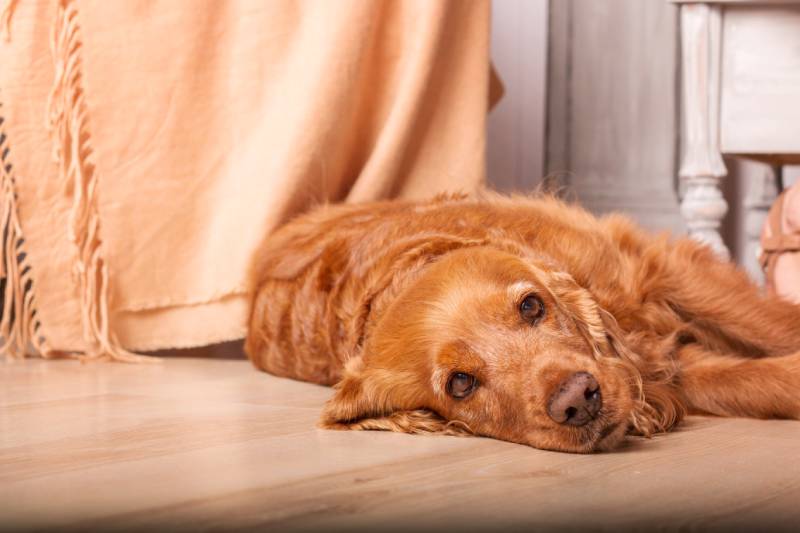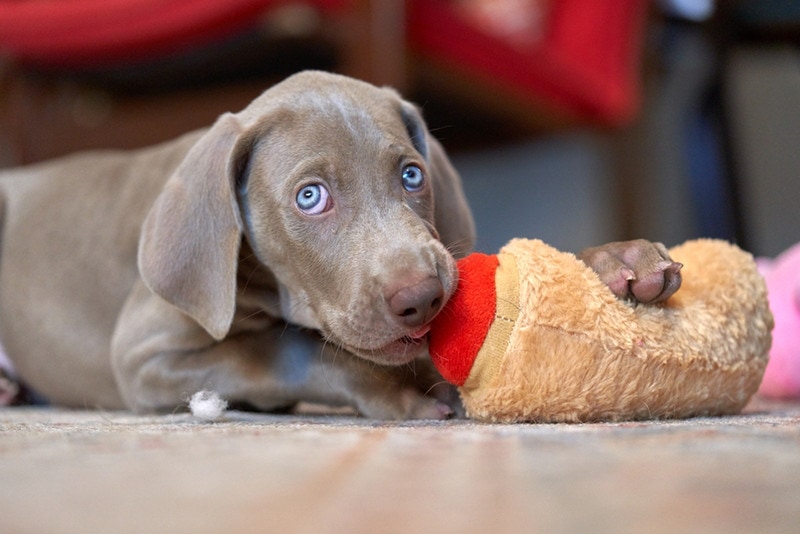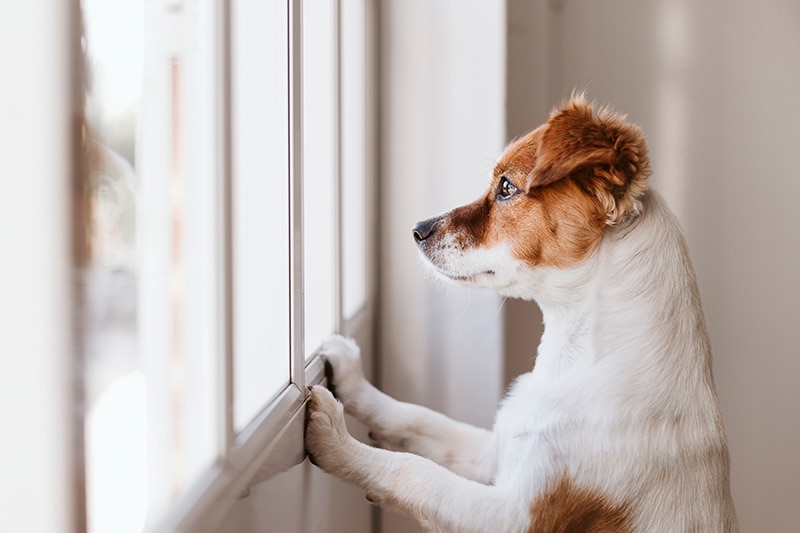We all know that dogs are highly sociable animals and love having us around. Unfortunately, some dogs become anxious and distressed when they are left on their own and this is commonly referred to as separation anxiety.
The signs that a dog will display with separation anxiety are variable but are typically unwanted and destructive behaviors, causing upset for both them and their human family. If, as a pet owner, you have ever suffered from anxiety or anxious feelings yourself, you can understand how unpleasant it is for your pup.
Separation anxiety is not uncommon, but it’s not always straightforward as to where or when it started. To help your dog learn that it’s ok to spend some time on their own, let’s ascertain some facts and answers regarding separation anxiety.
What Is Separation Anxiety?
Separation anxiety is the response your dog exhibits when you, their bonded carers, or the people they are used to having around them are not there. This can occur if you leave the house or your dog is left at the groomer. In extreme cases, it may be triggered by you merely leaving the room you are both in.
Signs of Separation Anxiety
It can be awful for you when, for example, you return home from leaving your dog to find a clearly distressed pet. In an age where stress and fear are becoming increasingly common in dogs, likely because we are becoming more aware of it as a disorder, what are the signs of separation anxiety so you can become aware as quickly as possible and take action?
You may find that your dog exhibits one or multiple of these signs:
- Panting
- Shaking
- Any form of destructive behavior, such as chewing, ripping, and clawing at furniture, flooring, or belongings
- Excessive drooling
- Clinginess, especially when they think they are going to be left alone
- Urinating or soiling in the house, in an otherwise house-trained dog.
- Barking, howling, whining, whimpering, or crying
- Restlessness/pacing, unable to settle
- Ears pulled back or pinned down
- Licking their lips
- Tail between their legs
- Repetitive behaviors, such as excessive licking
- Trying to escape confinement and related injuries
If your dog is showing signs of separation anxiety, we suggest you speak to a vet.
To talk to a vet online now, click on the image or button below:
The 4 Tips on How to Help Your Dog with Separation Anxiety
This takes time, consistency, and persistence, but is possible to solve. The goal is to help your dog become less fearful and more relaxed when you are not around while helping your dog feel less reliant on you and other members of the household.
Separation anxiety is a complex and vast area to treat, and advice and help should be sought from your veterinarian and a qualified dog behaviorist to yield the best results. A treatment plan is very much based on each dog and situation.
However, there are some general steps to take.
1. Recognize the Signs and Identify the Triggers

This initially reverts to the previous list and you as their pet parent noticing the signs and acknowledging there is an issue going on needing your attention. It’s then important to contact your vet so they can check your dog for any medical conditions that might display similar signs, before identifying that separation anxiety is the root of the problem.
Although there can sometimes be an obvious disruptive life event, or a significant change in routine that has led to the development of anxiety, often the underlying reason for your dog developing separation anxiety is not known. It can, however, be useful to see if you can pinpoint any specific triggers.
It is advisable to observe your dog and write these down so you have a clear picture. Is it when you leave the room or house, or is it when you leave them in unfamiliar places? Is it all of these? What signs and behaviors do they exhibit and when? After how long do they occur?
This can help you try and decipher if the behaviors are due to, or made worse by, loneliness, boredom, frustration, needing to go potty, wanting exercise, or because of noises and disturbances outside.
2. Start Training

Some sort of training or retraining program needs to be instigated, ideally under the direction of a qualified behaviorist. The following suggestions are a helpful start for most dogs.
- Do not leave your dog alone for long periods. Set up your phone or camera to record your dog while you step outside. Notice how long it takes for their anxious behaviors to start. With this information in mind, reduce the amount of time you leave them before you return home to just before the anxious behavior starts, and then increase slowly from there. Reward positive behavior and be consistent with return times. Some dogs may not be able to be left alone for any period of time at the start of a desensitization process.
- Leave special or favorite toys out to occupy and distract them. If they have something interesting and fun to do while you are gone, this can help. Examples can be security stuffed toys/teddies or blankets, their favorite balls, interactive puzzles, and treat balls and toys that you can stuff and fill with treats.
- Meet their basic needs. Have they been walked or taken out for a potty break? Did they actually urinate or defecate? Have they been properly exercised? Have they been fed? Is the house too cold or hot? Do they have water?
- Minimize disturbances. To a certain degree, and depending on the problem or noise, the following ideas may help you:
- Close the curtains, blinds, or shutters on all windows and doors
- Leave a radio or TV on to muffle noises
- Place them in a quiet space or room
- Introduce desensitization or counter-conditioning training. These are usually advised and derived from your vet or behaviorist and tailored to your individual dog’s needs. A desensitization program in essence gradually gets them used to being home alone by leaving them for short periods to start with, and gradually building up to longer periods of time.
- Never punish your dog for unwanted or negative traits and behaviors. Ignore the negative traits and incidences instead and give them no mind. Only reward positive and wanted actions and behaviors.
- Dog sitters and walkers. These are helpful options and are recommended if you are leaving any dog for more than 4 hours. Having other people check in on them periodically is also super comforting and helpful to them (and you!).
Your veterinarian or behaviorist may suggest anxiety medication or similar to help with their retraining program.
3. Don’t Ignore the Issue

Letting your dog “cry it out” is advice given by some training guides. This technique, sadly, is practiced quite widely but it is neurologically damaging and needs to be avoided. This is due to:
- Dogs and puppies left to cry it out and tolerate it will only learn that being alone is terrifying.
- Each time your dog is distressed, stress hormones occur and are released in the body which can take days to reduce and return to normal levels. This may cause negative long-term effects and problems with your dog’s physical and mental health and state.
- Some dogs, when using this practice, only learn that asking for their owner to come back doesn’t work and they will suffer in silence.
4. Get a Specialist Involved

With cases such as separation anxiety, especially if you tried the advice from here or from other reputable sources, getting a specialist involved is key. Treating separation anxiety can be complex and take time so it is always recommended to seek advice from a veterinarian, or a clinical behaviorist.
Any expert should be certified and fully qualified and you may wish to get information from places such as The American Veterinary Society of Animal Behaviour.
Do you have an anxious dog? A high-quality, pet-safe CBD oil may be able to help. We like CBDfx's Pet Tincture, which comes in four different strength levels and is made from human-grade, organic hemp. Even better, your dog will love the natural bacon flavor!
Conclusion
Separation Anxiety in dogs is a big topic to unravel. Rest assured, though, there is plenty of help available. Always consult with your veterinarian or dog behaviorist and act as soon as you notice any signs rather than ignoring it or seeing how it goes. Separation anxiety will only become worse and will not get better if no intervention is taken.
See Also:
Featured Image Credit: eva_blanco, Shutterstock












